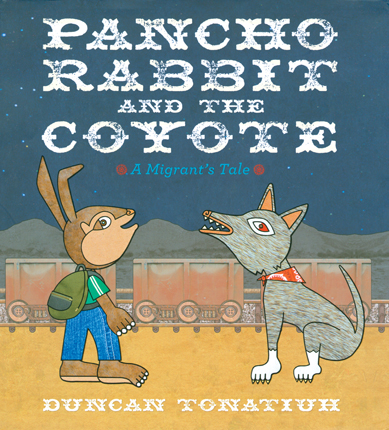Full Text Reviews: School Library Journal - 04/01/2013 K-Gr 2—When Papá Rabbit does not return from the lettuce and carrot fields of El Norte, Pancho Rabbit sneaks off in the night to search for him. He runs into Señor Coyote, who offers to help, but demands that Pancho give him the food he is carrying. When the mole, beans, and tortillas are gone, and they have finally crossed the big wall, Coyote is about to eat Pancho when Papá and his friends come to his rescue. Animals stand in for people in this morality play about immigration, allowing readers to see the migrant's side of the story. Children will learn a bit about Mexican culture from the hand-drawn and digitally collaged folk-art-inspired illustrations depicted in warm desert colors as well as from the author's note. The stylized, flat illustrations put the story in context and set the mood. The book shows the fragility of making a living, the desperation that many migrants experience, and the deep family ties that bind the characters. Classrooms studying the migrant experience will find plenty to discuss here.—Angela J. Reynolds, Annapolis Valley Regional Library, Bridgetown, NS, Canada - Copyright 2013 Publishers Weekly, Library Journal and/or School Library Journal used with permission. Bulletin for the Center... - 07/01/2013 Pancho’s papá, Papá Rabbit, is leaving with Señor Rooster and Señor Ram to cross the border—illegally—to find work in El Norte for months. When Papá and the other animal fathers don’t come home when they’re expected, Pancho, stocked up with tortillas, mole, rice, and beans, sets out to find his father. Accepting the help of a coyote (a literal one, in a play on coyote, an often corrupt smuggler who takes people across the border for a price), Pancho hops trains, swims rivers, and bribes the rattlesnake border officials to cross the desert into El Norte, doling out his dwindling stockpile of food and drink at each step as payment to the coyote. After it’s finally all gone and the coyote is still hungry, Pancho seems to be on the menu himself until the migrant fathers burst in, chase the smuggler away, and begin the trek home to reunite with their families. Tonatiuh is so careful in weaving his allegory that his empathetic contemporary tale feels like age-old folklore, with simple but compelling text and a step-by-step escalation of the story through gripping, kid-understandable challenges. The ink and digital collage illustrations evoke Aztec drawing with their distorted two-dimensionality: feet and heads are in profile, but arms and eyes face forward, and objects skew perspective to tilt toward the reader and display their most interesting side. Tonatiuh masterfully combines photographic elements to create a richly textured world (Coyote, for example, is textured with real coyote fur) and uses broad swaths of the gorgeous tans, browns, and oranges of the environment to draw attention to his characters and their journeys. An author’s note describes the realities of undocumented workers in the United States today and points to web resources for further information. A glossary of Spanish terms is also included. This thoughtful allegory provides a fresh approach to introduce kids to a tough issue, but the tale is interesting enough to stand as a modern folktale on its own. TA - Copyright 2013 The Board of Trustees of the University of Illinois. Booklist - 06/01/2013 In this pointed allegory, Pancho, a young rabbit, sets out for El Norte to find his father, who is late returning from the great carrot and lettuce fields. He falls in with a ravenous coyote who offers to guide him over the border (for a price), but when the food runs out, so does Pancho’s luck. In a rather large coincidence, he’s rescued from death by his Papá. Along the way, Pancho crosses a river, climbs a fence, and passes through a tunnel guarded by uniformed, bribe-taking snakes. Tonatiuh shapes his story along strong folkloric patterns, and he adds atmosphere aplenty in arresting, flat folk art with cultural references (coyote is the term for someone who smuggles people across the border). He closes with a critical, research-based author’s note about who illegal immigrants are and the dangers they face, capped by a list of web reports and resources. The depiction of the border’s barriers and those who patrol them may be discomfiting for some, but with so little on the topic available for younger readers, it’s good to have a book that can be read at several levels. This will spark strong responses and needed discussion. - Copyright 2013 Booklist. Loading...
|



